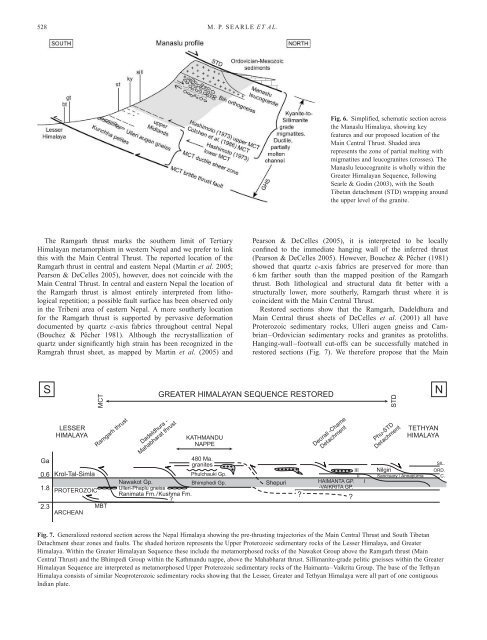Defining the Himalayan Main Central Thrust in Nepal - Queen's ...
Defining the Himalayan Main Central Thrust in Nepal - Queen's ...
Defining the Himalayan Main Central Thrust in Nepal - Queen's ...
You also want an ePaper? Increase the reach of your titles
YUMPU automatically turns print PDFs into web optimized ePapers that Google loves.
528<br />
M. P. SEARLE ET AL.<br />
Fig. 6. Simplified, schematic section across<br />
<strong>the</strong> Manaslu Himalaya, show<strong>in</strong>g key<br />
features and our proposed location of <strong>the</strong><br />
<strong>Ma<strong>in</strong></strong> <strong>Central</strong> <strong>Thrust</strong>. Shaded area<br />
represents <strong>the</strong> zone of partial melt<strong>in</strong>g with<br />
migmatites and leucogranites (crosses). The<br />
Manaslu leuocogranite is wholly with<strong>in</strong> <strong>the</strong><br />
Greater <strong>Himalayan</strong> Sequence, follow<strong>in</strong>g<br />
Searle & God<strong>in</strong> (2003), with <strong>the</strong> South<br />
Tibetan detachment (STD) wrapp<strong>in</strong>g around<br />
<strong>the</strong> upper level of <strong>the</strong> granite.<br />
The Ramgarh thrust marks <strong>the</strong> sou<strong>the</strong>rn limit of Tertiary<br />
<strong>Himalayan</strong> metamorphism <strong>in</strong> western <strong>Nepal</strong> and we prefer to l<strong>in</strong>k<br />
this with <strong>the</strong> <strong>Ma<strong>in</strong></strong> <strong>Central</strong> <strong>Thrust</strong>. The reported location of <strong>the</strong><br />
Ramgarh thrust <strong>in</strong> central and eastern <strong>Nepal</strong> (Mart<strong>in</strong> et al. 2005;<br />
Pearson & DeCelles 2005), however, does not co<strong>in</strong>cide with <strong>the</strong><br />
<strong>Ma<strong>in</strong></strong> <strong>Central</strong> <strong>Thrust</strong>. In central and eastern <strong>Nepal</strong> <strong>the</strong> location of<br />
<strong>the</strong> Ramgarh thrust is almost entirely <strong>in</strong>terpreted from lithological<br />
repetition; a possible fault surface has been observed only<br />
<strong>in</strong> <strong>the</strong> Tribeni area of eastern <strong>Nepal</strong>. A more sou<strong>the</strong>rly location<br />
for <strong>the</strong> Ramgarh thrust is supported by pervasive deformation<br />
documented by quartz c-axis fabrics throughout central <strong>Nepal</strong><br />
(Bouchez & Pêcher 1981). Although <strong>the</strong> recrystallization of<br />
quartz under significantly high stra<strong>in</strong> has been recognized <strong>in</strong> <strong>the</strong><br />
Ramgrah thrust sheet, as mapped by Mart<strong>in</strong> et al. (2005) and<br />
Pearson & DeCelles (2005), it is <strong>in</strong>terpreted to be locally<br />
conf<strong>in</strong>ed to <strong>the</strong> immediate hang<strong>in</strong>g wall of <strong>the</strong> <strong>in</strong>ferred thrust<br />
(Pearson & DeCelles 2005). However, Bouchez & Pêcher (1981)<br />
showed that quartz c-axis fabrics are preserved for more than<br />
6 km far<strong>the</strong>r south than <strong>the</strong> mapped position of <strong>the</strong> Ramgarh<br />
thrust. Both lithological and structural data fit better with a<br />
structurally lower, more sou<strong>the</strong>rly, Ramgarh thrust where it is<br />
co<strong>in</strong>cident with <strong>the</strong> <strong>Ma<strong>in</strong></strong> <strong>Central</strong> <strong>Thrust</strong>.<br />
Restored sections show that <strong>the</strong> Ramgarh, Dadeldhura and<br />
<strong>Ma<strong>in</strong></strong> <strong>Central</strong> thrust sheets of DeCelles et al. (2001) all have<br />
Proterozoic sedimentary rocks, Ulleri augen gneiss and Cambrian–Ordovician<br />
sedimentary rocks and granites as protoliths.<br />
Hang<strong>in</strong>g-wall–footwall cut-offs can be successfully matched <strong>in</strong><br />
restored sections (Fig. 7). We <strong>the</strong>refore propose that <strong>the</strong> <strong>Ma<strong>in</strong></strong><br />
Fig. 7. Generalized restored section across <strong>the</strong> <strong>Nepal</strong> Himalaya show<strong>in</strong>g <strong>the</strong> pre-thrust<strong>in</strong>g trajectories of <strong>the</strong> <strong>Ma<strong>in</strong></strong> <strong>Central</strong> <strong>Thrust</strong> and South Tibetan<br />
Detachment shear zones and faults. The shaded horizon represents <strong>the</strong> Upper Proterozoic sedimentary rocks of <strong>the</strong> Lesser Himalaya, and Greater<br />
Himalaya. With<strong>in</strong> <strong>the</strong> Greater <strong>Himalayan</strong> Sequence <strong>the</strong>se <strong>in</strong>clude <strong>the</strong> metamorphosed rocks of <strong>the</strong> Nawakot Group above <strong>the</strong> Ramgarh thrust (<strong>Ma<strong>in</strong></strong><br />
<strong>Central</strong> <strong>Thrust</strong>) and <strong>the</strong> Bhimpedi Group with<strong>in</strong> <strong>the</strong> Kathmandu nappe, above <strong>the</strong> Mahabharat thrust. Sillimanite-grade pelitic gneisses with<strong>in</strong> <strong>the</strong> Greater<br />
<strong>Himalayan</strong> Sequence are <strong>in</strong>terpreted as metamorphosed Upper Proterozoic sedimentary rocks of <strong>the</strong> Haimanta–Vaikrita Group. The base of <strong>the</strong> Tethyan<br />
Himalaya consists of similar Neoproterozoic sedimentary rocks show<strong>in</strong>g that <strong>the</strong> Lesser, Greater and Tethyan Himalaya were all part of one contiguous<br />
Indian plate.

















